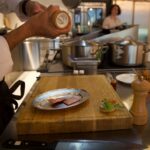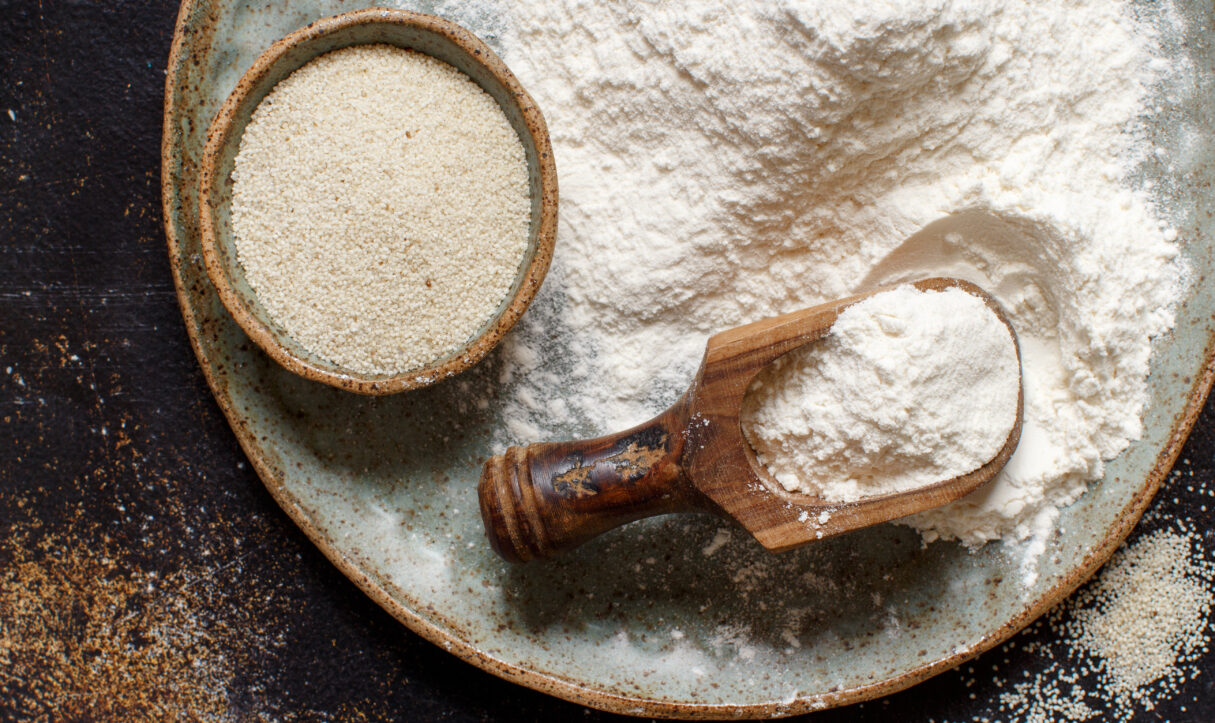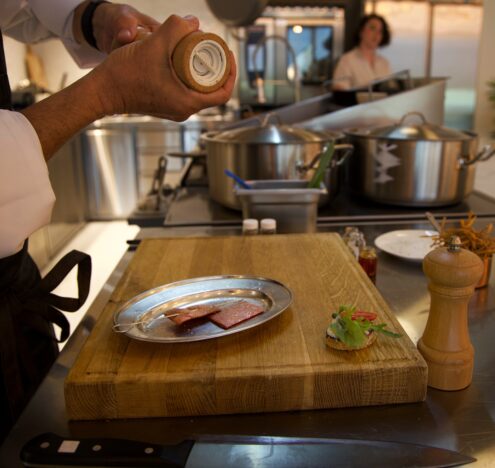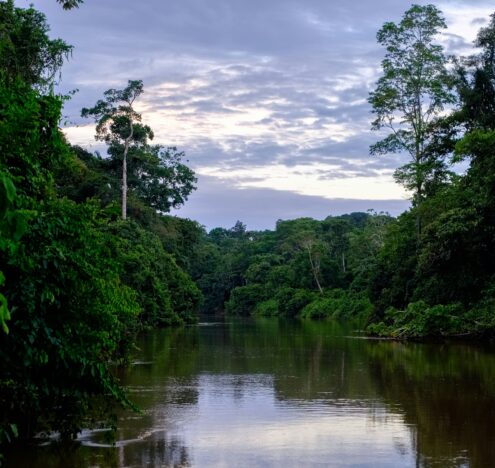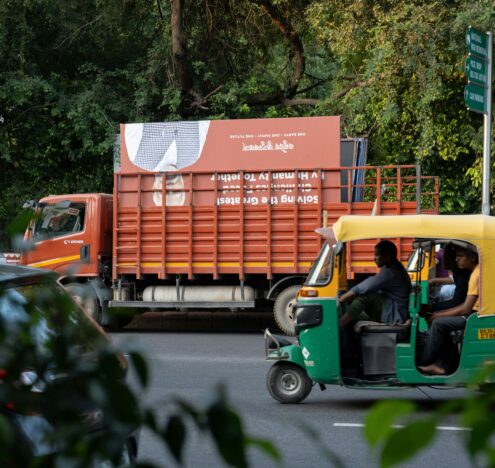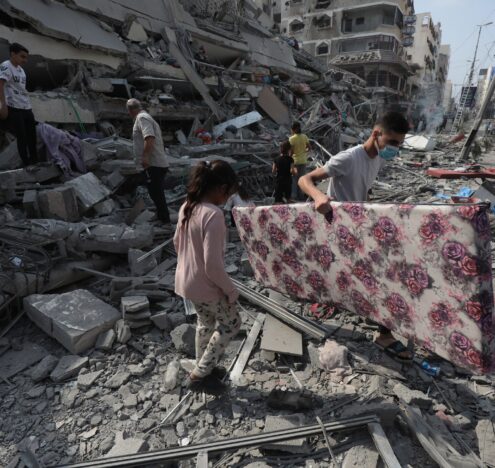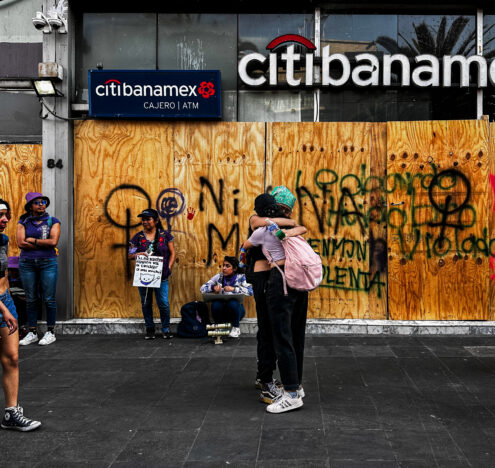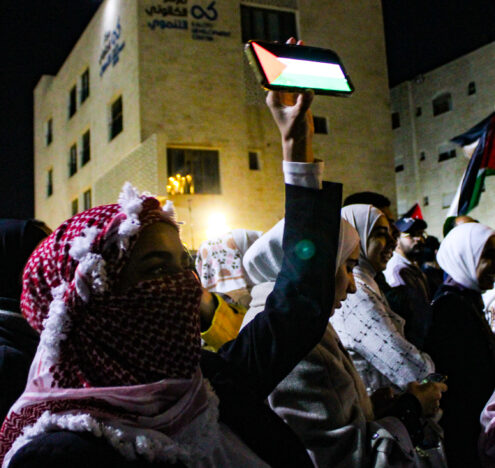There are tens, or even hundreds, of thousands of edible plants in the world. But humans only cultivate a couple hundred of those at any significant scale. And when we eat, we tend to stick to just a few: More than half of the calories that humans consume around the world today come from just corn, soy, wheat, and rice. But that narrow focus on food is putting us in danger.
As climate change, the COVID pandemic, and conflict in “breadbasket” regions like Ukraine continue to disrupt agriculture, it may be time for forgotten crops to make a comeback. On this episode, Chef Pierre Thiam explains how one of these ancient grains might just save the world.
Listen and subscribe now on Apple Podcasts, Stitcher, Spotify, Pocket Casts, or wherever you get your podcasts to receive a new episode every two weeks.
Guest: Pierre Thiam, Chef, author, & entrepreneur
Additional Resources:
Where to find some fonio: Yolélé
How to cook fonio: The Fonio Cookbook by Pierre Thiam
Will the world’s breadbaskets become less reliable?, McKinsey (charts and maps!)
Looking at other grains (millet and fonio) to help feed the world, Foreign Policy
Explore stats on crop and livestock production around the world, The UN Food and Agriculture Organization
Transcript:
LAICIE HEELEY: Last week, I decided to take a trip to my local grocery store in Frederick, Maryland, with… a mission.
Taking my grains…. Gonna go do my thing. [car door shuts]
I have one shopping bag full of all my grains and some bowls and I have another shopping bag full of full-size candy bars.
I set myself up with five bowls of grains next to the shopping carts so that I could catch people on their way in the store.
[FUN MUSIC]Any chance I can bug you for like five minutes?
Any chance I can bug you for like three minutes?
Can I talk to you for like three minutes? It’s a game. I have prizes, I’m a journalist.
So I have these grains and I just want to ask you, real quick, if you recognize them.
LINDA: Of course.
LAICIE: So this one right here, what is– what is this guy?
LINDA: They’re corn–corn kernels.
LAICIE: Corn kernels, perfect.
I had some that were fairly obvious…
SHOPPERS: Rice
Rice
That looks like corn.
That looks like wheat.
It appears to be corn.
Corn.
LAICIE: And some that were a little trickier.
LAICIE: This one?
SHOPPER: It looks like bird seed. [laughs]
SHOPPER: Chia seed?
LAICIE: Uh, it’s quinoa.
SHOPPER: Oh!
LAICIE: So that’s progressively harder.
And then the grand finale.
And then this one.
JIMMY: Hmm, don’t know.
LAICIE: What does it look like to you?
JIMMY: Looks like ground sea salt.
SHOPPER: I’m not even gonna try to guess.
SHOPPER: Yeah, it looks like sand. [laughing] I wouldn’t know.
LAICIE: It does, it kind of looks like sand.
Nobody guessed this one.
Yeah. What does it feel like?
CURTIS: It’s grainy but it’s not grainy-hard. It’s grainy like if you put liquid on it, it’s going to dissolve.
[THEME MUSIC]LAICIE: This grainy little grain? It’s called fonio.
I’ve got another one in here if you wanna take it with you.
WENDY: Oh! I would like to try it!
LAICIE: Yeah, cool.
CURTIS: Oh my god. I’m glad I stopped. I’m making curry goat tomorrow. Jamaican curry goat.
LAICIE: But as great as fonio may be with that goat, that’s not all it’s about. Some people think it might just save the world.
So today we’re going to introduce you to one of those people.
I’m Laicie Heeley and this is Things That Go Boom.
PIERRE THIAM: Fonio is a tiny little grain that looks like couscous and it’s been cultivated for over 5,000 years in Africa. It used to be cultivated all across Africa.
LAICIE: This is Pierre Thiam. And…he’s got a lot on his plate, so to speak.
He’s a celebrated chef with restaurants in New York, Lagos, and Dakar. He’s also an author, an activist, he’s an entrepreneur…
And he really likes fonio.
PIERRE: It’s quite delicious. It cooks in five minutes.
LAICIE: Like, A LOT.
PIERRE: They call it the grain for royalty because of its delicate taste. And it’s quite versatile ‘cause it has a neutral flavor so it can be adapted to so many different types of cuisines. And it’s a nutrition powerhouse. It’s gluten free, rich in proteins.
It’s fluffy. It doesn’t have the heaviness of couscous, it’s easy to digest, fonio scores low on the glycemic index. So, there’s like so much going for fonio.
LAICIE: Fonio is in the same category as the cereal grains we’re all familiar with. Like rice, wheat, and corn…it’s basically just grass with nutritious seeds.
But Pierre told us that fonio’s magic goes well beyond just being a tasty alternative option for a side dish… because unlike its world-famous friends, fonio is naturally well adapted to grow in some particularly tough conditions.
PIERRE: It’s amazing for the environment because fonio can grow in poor soil. It’s a grain that grows in an area called the Sahel, which is south of the Sahara Desert.
LAICIE: The Sahel stretches across the continent of Africa from Senegal on the Atlantic Ocean all the way to Sudan on the Red Sea.
And it’s an area where crop failures come at an especially high cost. The UN warned last spring that 18 million people across this region are facing severe hunger.
PIERRE: That area is dry, it’s arid, but Fonio can grow there. It can actually thrive there because it’s a drought resistant grain. And it has this amazing thing because it has deep roots that add nutrients to the soil so it regenerates the soil.
So there’s so many things that I can tell you about fonio. It’s good for you. It’s good for the environment. It’s good for the planet. It’s good for the foodies.
There’s a saying that says fonio never embarrasses the cook. That’s what the Bambara people say.
LAICIE: Today, Pierre is Mr. fonio. He gives TED talks…
PIERRE TED VIDEO: This tiny grain may provide big answers. Taking us one step closer to the universal civilization. Thank you. [applause]
LAICIE: And he gives on-stage fonio cooking lessons to people like Bill Gates.
PIERRE GATES FOUNDATION VIDEO: We’re going to cook fonio. And I’m going to go around and explain to each one of you what you are supposed to do. We’ll start with Bill. Your hands are clean? Ok, so this is what you are going to do….
LAICIE: But this is not necessarily how he saw his life going.
PIERRE: My younger self would be [chuckles] laughing for sure!
LAICIE: Pierre was born in Senegal. And, as a kid, he lived in the capital city… so he didn’t think too much about this grain from his homeland.
PIERRE: Growing up in Dakar, I never even had fonio. I would have Fonio only when I would go during the summer vacation to visit my grandparents in the South.
LAICIE: As a young man in the late 80s, Pierre moved from Dakar to New York City and started his career as a chef in the US…but he noticed that something was missing.
PIERRE: The food from my place of origin were not represented in the so-called food capital of the world. And I was like this is a big miss and this is a big opportunity.
LAICIE: He started introducing West African dishes in the restaurants where he worked, then eventually opened his own restaurant and started writing cookbooks focused on the food he grew up with.
PIERRE: The first cookbook was about the food that was inspiring me. The second cookbook, I wanted to go and meet the farmers, meet the producers and get that story to my audience.
LAICIE: So he boarded a plane and flew to Senegal.
PIERRE: And as I’m traveling, I’m in that part of Senegal called Kédougou in the most remote part of Senegal. And that’s where the fonio cultivation is still very vibrant
LAICIE: Pierre describes Kédougou as a stunningly beautiful place that wows visitors with views of the Fouta Djallon Mountains. But it is also one of the poorest regions in the world– a place where people go hungry.
And it’s there that he rediscovers the grain that would drastically change his career.
PIERRE: I’m being offered this grain and I’m like, oh wow, I remember this flavor from childhood. This was so delicate.
How come this is not accessible? Cause this grain, I’m sure in New York City people would love it. I am a chef in New York City and I’m like, I know if I present in my restaurant… and it’s getting to be early 2000 and quinoa is starting to become a thing.
COOKUSINTERRUPTUS VIDEO: I’m gonna show you how to cook Quinoa. Quinoa is spelled q-u-i-n-o-a which would make you think that it’s pronounced “kwin-oh-ah” but it’s actually pronounced ‘keen-wah”.
PIERRE: And I’m like, well, this grain from the Andes in Latin America made it to the world. So fonio could have the same trajectory.
And I can learn from the lessons. Avoid to fall into the same pits that quinoa fell into. You know, there are some things that quinoa unfortunately didn’t do to benefit those who should be their ultimate beneficiaries, the small farmers.
LAICIE: Without collaboration from small farmers, increased fonio production might fail to provide the benefits that Pierre hopes to see.
PIERRE: Let’s not turn fonio into a cash crop. You know, this is not what it’s about. We need to support the whole system. You know, we need to support the community that’s growing them.
LAICIE: Fonio wasn’t always so obscure. Once upon a time, it was highly prized, cultivated across a large part of the continent and even entombed with the pharaohs in Egypt.
PIERRE: That’s just the funny thing about it is a grain like this is not accessible in the big cities in Africa– the market is not there. We keep thinking of fonio as like, Peasant grain, it’s like this crop for people from the country.
Sometimes, you would see crops that travel from further. Like we grow wheat, we eat wheat. Sorry, we don’t grow, we don’t grow wheat, we eat wheat, we eat baguette bread. You know, the French, colonial past in Senegal has made it such a thing that wheat is a big thing.
LAICIE: The French colonized Senegal and held the territory until Senegalese independence in 1959. And, while they were in control, the French chose to shape local agriculture in ways that were most beneficial to them.
Meaning that fonio didn’t just fade out of use.. it was pushed out.
It’s a story Pierre sees written all throughout the cuisine from his homeland.
PIERRE: I mean, for me, in the case of Senegal, I can be looking at my national dish, Thiéboudienne, which is a dish with broken rice and fish and vegetables. It’s a delicious dish, but the broken rice is intriguing. Why is it broken rice? And you realize that broken rice is actually not a whole rice.It’s rice debris from processed rice.
And then it takes you to colonial time, and then you realize that there’s a moment where the French wanted the Senegalese farmers to grow peanuts and cotton.
The French had a big empire. So they had IndoChina in Vietnam. And in Vietnam, they had a rice growing culture but, when they were growing rice after processing it, the debris…. The Vietnamese would take it away for their animal feed.
So the French took those debris and brought it to Senegal so that the farmers in Senegal wouldn’t be growing millet or fonio or stuff like that.They would grow peanuts and cotton. And the debris imported in shipping containers from Vietnam would be feeding us.
And we embraced it. And with such good cooks, we made these great dishes with it. Even 60 years after independence, we are still importing rice debris from Vietnam to make this national dish.
LAICIE: It goes without saying that as much as Pierre still loves to cook, and eat, dishes like Thiéboudienne, he’d also like to see native grains like fonio make a comeback.
But fonio’s comeback isn’t without its challenges.
PIERRE:Fonio is a tiny grain that’s easy to grow but difficult to process because it has a skin that needs to be removed. The skin is inedible. The processing was time consuming. At first, fonio was processed with a mortar and pestle, so it was manual. So to have like one kilo of fonio, it would take two hours of pounding.
LAICIE: But Pierre says some specialized processing equipment is now available to process one ton of fonio per day.
PIERRE: Now, we are setting up a mill in Mali to process the fonio. And that mill is connected with a network of small farmers that we contract every season to produce fonio for the mill.
LAICIE: It’s all a part of Pierre’s plan to find a global market for fonio.
PIERRE: I just thought I would start first by introducing it to my clients at the restaurant, and then gradually introduce it to other chefs, my colleagues who are always looking for new products, new ingredients.
And, and then eventually the consumers will ask for it, and the market will be open to distributing it. That was the naive thinking behind this thing. I was like, I’m going to…
LAICIE: Oh! (laughing)
LAICIE: I’m laughing because Pierre’s actual journey doesn’t look too different from the path he’s describing here. About a decade ago, he started sharing fonio with people in the US.
One day, he sat down with his publisher and they started talking about the fonio chapter in his new cookbook. And he could see right away that she was excited about fonio’s potential. So he kept sharing.
PIERRE: And as I’m telling the story, everyone is fascinated and I’m bringing some fonio samples to chefs and they’re also having fun and making things that you never thought you could be making with fonio.
I was making sushi with fonio instead of rice. I was making some beautiful stuff. And you can bake with fonio. So everyone was very encouraging and that kept me going. I was like, I can do it. We can introduce fonio to the world.
LAICIE: If he was going to make fonio a household name, though, he was going to have to team up with someone who knew the ins and outs of ancient grains.
PIERRE: I have to say I shouldn’t take the credits for taking it to the masses. I partnered with my co-founder Philip Teverow who’s also a veteran in the food industry.
LAICIE: Philip has been working on this stuff since the quinoa craze.
And the two of them teamed up with a distributor who had the skills to manage logistics and get the products to the market. Then they built up those critical relationships with farmers in West Africa to grow the fonio… and that meant all that was left to do was get people interested in buying fonio.
PIERRE: The first client we approached was Whole Foods, because Whole Foods were opening one in Harlem near my restaurant.
So I was there myself just cooking, doing some cooking demo and tastings at Whole Foods, having a small table.
LAICIE: This feels a little bit like Banksy selling art in the subway station or Beyonce showing up at my local karaoke bar.
PIERRE: And every time we would do that, we would just sell out a fonio. Every single time we would do a cooking demo, people would taste it and they would just connect with it and then they would go on the shelves and buy the fonio.
LAICIE: Sales were so successful that fonio is now available in Whole Foods nation-wide. And they are still expanding.
PIERRE: So that’s also the thing because the company, Yolélé, is an African food brand. So we want it to be not just about one grain but about a food culture.
LAICIE: So they’ve introduced some ready-to-cook products like a fonio pilaf. It’s full of veggies native to the Sahel.
PIERRE: That one has moringa in it. It has baobab in it. So it has all those really underutilized crops from the region that are very nutritious, very special, and that grow there, in a way that’s sustainable.
We also have chips now. The chips are our entrance into the snack category. With ingredients like, you know, dawadawa, which is a fermented locust bean from West Africa as well. That brings an–uh, we call it the Afro-funk.It brings a nice umami flavor to it.
Interestingly, we even have fonio beer that we did a collaboration with Brooklyn Brewery. So that was a limited edition Brooklyn Brewery.
LAICIE: Oh, that’s cool
PIERRE: Yeah, it was very cool.
Really delicious white beer. Quite delicious actually.
LAICIE: But this diversity isn’t just nice for Brooklynites who get to drink a new type of craft beer. Or even for the farmers with access to new markets for their crops. Diversifying the global diet is key to ensuring prosperity, political stability and, ultimately, even the survival of everyone on earth.
That’s after the break.
[BREAK]LAICIE: A couple weeks ago, in between a first-grade basketball game and the 14th kids birthday party of the week, if you know you know, I was trying to catch up on some news. And I caught sight of what seemed to be a new buzzword roaming around in the wilds of global affairs.
[MONTAGE]
NED PRICE: What we call the Three Cs
- RAMIN TOLOUI: Let me speak to something I think is very important cutting across all the Three Cs.
CINDY MCCAIN: The Three Cs we call it.
LAICIE: The Three C’s refer to Climate Change, Conflict and Covid.
… and they’re all bad enough on their own.
But together, it turns out they’re wrecking the global food supply. You can see them behind everything from inflated grocery prices to famine.
And unfortunately, risks like The Three Cs are not going away.
We’ve actually unwittingly made them more dangerous with some really bad agricultural strategy.
PIERRE: And that’s how foolish we are! I mean, how can we rely on like four crops? And, those crops are grown in concentrated regions of the world. If there’s something that happened in that region, the whole world is in trouble.
LAICIE: You’ve probably heard that wheat from Ukraine has been destroyed, delayed, or just never planted because of Russia’s invasion and the ongoing war.
And regions in Russia and Ukraine typically grow about one-third of all the wheat consumed around the world.
In fact, all of the top crops in the world are highly regionally concentrated like this. Most rice just comes from one region in China. A great proportion of the world’s soy is grown in a subregion of Brazil… corn in the American midwest.
When just one of these “breadbasket” areas can’t produce, we see food prices go up and food security go down. But it isn’t hard to imagine how several of these critical zones could get hit at once.
PIERRE: That could be a war, that could be a gene, that could be something wrong with the seed itself.
And we are ignoring thousands of other crops. We’re ignoring them. We’re ignoring fonio, we’re ignoring millet, we’re ignoring sorghum, we’re ignoring amaranth, all those crops are there that we need to figure out how to integrate them into our food system in case there’s a problem with wheat in Ukraine or there’s a problem with corn in that region where corn is being grown.
LAICIE: About half of the calories that humans consume around the world come from just corn, rice, wheat and soy.
There are tens–or even hundreds–of thousands of edible plants in the world. But humans only cultivate a couple hundred of those at any significant scale. And the real scientific research and concerted effort to improve agriculture goes to just a tiny fraction of those.
Areas like the Sahel, that the western world has overlooked and exploited for generations, they have an abundance of plants that could feed the world.
PIERRE: One quarter of the world’s food plant diversity is in Africa. You know, crops like fonio that have not developed, that are not being distributed, that are just being ignored. They call them lost crops. They call them orphan crops. They have all kind of names for that to just tell you how they’re being ignored.
And when there’s a crisis anywhere around the world, Africa or Senegal, we are facing challenges because there’s disruption. There’s always a risk of famine.
And we haven’t even exploited our own resources, our own crops, our own, I mean, fonio is there, that grows easily and that is much more delicious and healthier than wheat, but it’s there and people are dying of hunger.
LAICIE: Pierre says that utilizing these orphan crops could go way beyond just preventing famine in African countries.
PIERRE: So Africa is a continent that is a net importer of food. And that’s amazing when you think of it as that continent that has 60% of the world’s arable land.
We should be feeding the world. That’s an opportunity for the world to actually really rethink the food system by taking advantage of not only these underutilized crops that are in Africa, but of the land that’s arable, that’s there, that’s still healthy.
You know, unlike all the parts of the world that has destroyed the soil. Because of monoculture or unhealthy agricultural practices and chemicals and all of that.
So Africa has a great opportunity.The world has a great opportunity providing, obviously, that we realize that, and we approach it in a way that’s considering the communities. That’s also considering the health of the planet, the health of the people, of the consumers. It’s just a different approach, but it’s a revolution
LAICIE: Unlike the farmland shortage facing China and lots of other places, the African continent has more land than it needs to be self-sufficient.
But right now, in places like Sahel, that isn’t enough to alleviate famine or poverty.
Because remember all that corn, soy, and wheat the world is eating? Well, those plants thrive in Iowa or southeast China …but tend to wither away in Senegal. And, without strong markets for the crops that can thrive locally, communities struggle.
PIERRE: When I was doing my research for the book and I end up in this part of Senegal where they still grow fonio, but there’s no youth there because there’s no jobs.
This grain that they grow, they just grow it for their bowl, for their lunch and dinner and for their food, but they don’t have a market for it.
So it’s not a source of income. So those kids, those youth, are leaving. And you see the tragedy. You may or may not have heard of what’s happening in Europe and like, hundreds and thousands of Africans are arriving.
And you should see now the conditions in which they’re living. Some of them are trying to cross the Sahara Desert, like by foot. For months, they’re crossing the Sahara. Half of them make it. Some take dugout fishing boats and try to cross the Mediterranean. They go from Senegal to Spain.
And those migrants, they take all their family savings, they get the blessings from their parents to go and risk their lives to try to go to Europe to have a job, to make a living and send money back home.
LAICIE: Large-scale agriculture requires many types of workers. Not just farmers, but factory workers, and marketers, and drivers, and strategists… and Pierre hopes that new professional opportunities at home might allow more young people to stay.
PIERRE: They, some of them, go just to go to Dakar, to the cities and that’s just–all of it is connected to hunger, to lack of opportunities. Those kids just want to have jobs.
And if they have those jobs and that at home, if they have their food guaranteed at home, no one would want to leave a beautiful region like Kédougou. I mean, it’s like, you have your family, your loved ones there. They’re not doing it because they want to die. But they just have no other option. And that’s what we have to realize.
And that’s a problem that concerns all of us. I mean, Europe is, like, upset. You see the rise of all kind protectionism and they want to stop these migrants to arrive, but they have to realize that they’re also connected to the situation out there.
LAICIE: The Biden administration has said that the US wants strong relationships with the countries of Africa. Which is why, in December, it hosted a summit with leaders from 49 African states.
Members spent three days in Washington DC talking about a bunch of subjects. Climate change, conflict, food security.
But not everyone was impressed with the conversation.
ARIKANA CHIHOMBORI-QUAO ON AL-JAZEERA: I’m hoping that the United States can begin to realize that it’s no longer business as usual. It’s no longer a case of the United States saying, ‘We make policy and we tell the Africans.’ That has got to change.
LAICIE: Dr. Arikana Chihombori-Quao is a former African Union representative to the US.
She told a reporter for Al Jazeera that the agenda for the summit was developed without input from African leaders and that lack of respect is threatening the US’s position as the preferred trading partner of many African countries.
ARIKANA CHIHOMBORI-QUAO: You go in feeling superior, you come back feeling superior. That is not an issue with the Chinese. They understand that Africa has something that they need. So they will come to the Africans. They will come and make sure that they let the Africans know that ‘You matter to us.’ That, ‘Our relationship with you does matter.’ That–you don’t get that feeling with the United States. You get the feeling that there’s this sense of superiority. That, ‘You Africans, that you ought to be glad that we are engaging you. You ought to be glad that we are inviting you to come to Washington.’ That sense of superiority, it has to change.
LAICIE: The US strategy toward Africa often feels like an afterthought compared to strategy in Asia or Europe. And policies focused on avoiding disaster can miss the chance to cultivate opportunities.
As we all struggle with the “Three Cs” …and head into a future where food access could be precarious, Pierre says that recognizing Africa’s strengths is key.
PIERRE: Africa is going to be 2 billion people on the planet in like, in 20 years, not even.
The solution is in our own soil. The solution is not by sending aid to Africa. Sending wheat? What is it gonna do? Sending flour, sending corn, maize? No. There’s crops that are there that not only by using them, unlocking them, by promoting them, by opening markets for them. You give jobs, you feed yourself, you feed the planet, you save the environment, you save biodiversity
I mean, for me, it’s like going to school every time I travel and, and go in those regions and spend time just with the farmers.
And that’s knowledge that has been transmitted for generations. Imagine how our ancestors domesticated those crops. And then figured out how to create recipes and cook those recipes. And those recipes are transmitted from generation to generation, especially in Senegal, in Africas, like her mother is passing the recipe to her daughter.
It’s still being done this way. And the daughter, she cooks the recipe, but that recipe is connecting her directly to like the great, great, great grandmother who had passed it on. So it’s like this direct link and that’s beautiful. You know, that really is really when food is at its right place, when food is culture, food is community, food is getting us together and food is playing that role.
LAICIE: Pierre has known food could bring people together since he was a little kid in Senegal… where there is a particular word for sharing with those around you.
PIERRE: We call it teranga, it’s the name of my restaurant. Teranga is when you share the best of what you have and usually it’s symbolized by the food. You know, we think the stranger–the person–especially the unexpected guest is like some kind of an angel that’s bringing a blessing and you can receive the blessing by giving him food or him or her food.
I wake up inspired that I’m doing something right for my people. Seeing them take pride in something that’s been passed upon them by their ancestors is one thing.
In addition to that, it’s having a great impact on the environment. That’s amazing., I grew up in a time of Senegal where we had desertification . The desert was approaching, it was really scary. Famine was coming. And then in the eighties, famine in Ethiopia.
So all of those things didn’t make sense when I understood that we have the most arable land in the world. We have crops that are there, that are resilient, that can feed us and feed the world, you know?
My younger self, he will be proud to see that I brought teranga with me. I kept that culture with me. I was trying to bring my culture and, and that led me to here.
I had no idea that I would be, one day, just be the champion of fonio.
LAICIE: Things That Go Boom is distributed by Inkstick Media and PRX. This episode was produced by Nikki Galteland and me, and edited by Katie Toth and Christina Stella.
Our music for the show is written by Darien Shulman, and Robin Wise makes each episode sound as fantastic as corn in a bowl.
[SOUND OF CORN IN A BOWL]Thanks to the supporters and foundations that make our work possible: the Carnegie Corporation of New York and Ploughshares Fund, as well as Inkstick’s supporters, including the Colombe Foundation, Craig Newmark Philanthropies, Prospect Hill Foundation, and the Jubitz Family Foundation.
If you’re listening and like what we do, we’d love to hear from you. Go on over and leave us a review. And come visit us any time on social @inkstickmedia. We’ll see you right back here, with our final episode of the season, in two weeks.
PIERRE: They call it the grain for royalty.
There’s a saying that says fonio never embarrasses the cook.
They call it the seed of the universe.
They call it the women’s grain.
There’s a saying, fonio is a lazy farmer’s crop.
You know what, we have a saying… I like to say sayings, right? But in Senegal we say, when you’re lost, you have to go back to where you came from.


